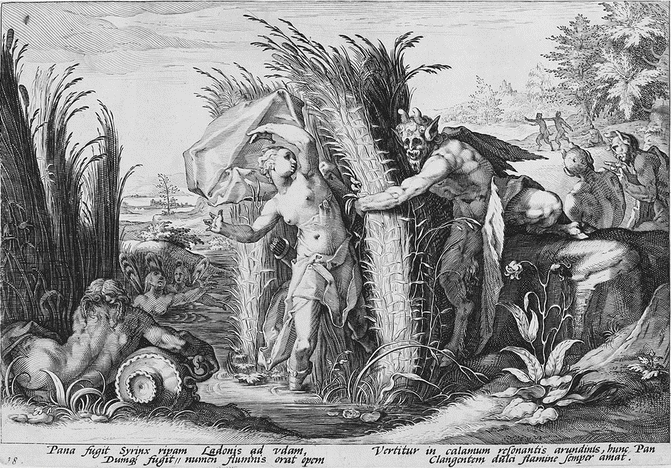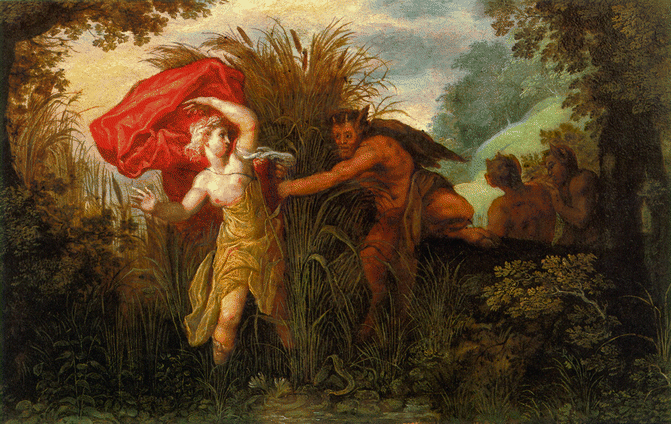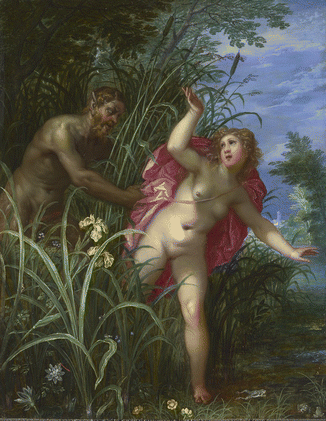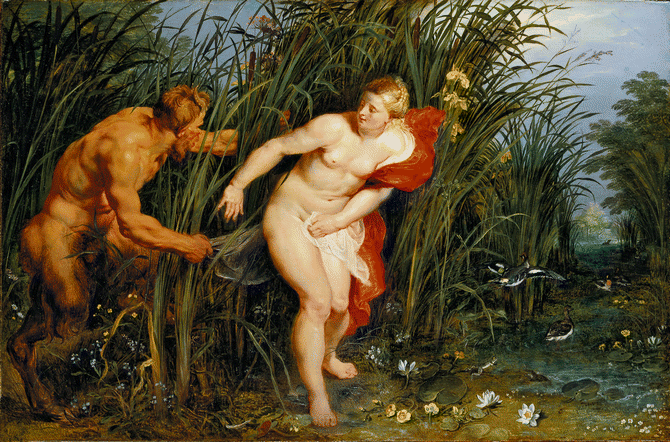Fig. 22.1
Pan and Syrinx, Bernard Salomon, 1552 (Herzog August Bibliothek Wolfenbüttel)
The third scene, portrayed just to the right of the second, shifts the illustration into obliquely related realms. It shows a heifer springing out of the picture. This is an allusion to the story of Io, a priestess of Argos who was transformed into a heifer by Zeus, in order to hide his adulterous designs from his wife Hera. When the heifer was tethered to a tree by the suspicious Hera and set under the guardianship of the hundred-eyed Argus Panoptes, Zeus gave Mercury the task of stealing her away. Mercury accomplished this task by distracting Argus with the story of Pan, Syrinx and the invention of the “Pan flute”. The telling of this tale succeeds in lulling Argus to sleep – a rather odd and disillusioning detail, since Mercury appears never actually to get around to playing any soporific tune on the flute itself. Rather, he sends Argus to sleep through his tedious style of story-telling. The aim is nevertheless achieved and the heifer Io is able to spring free. A fourth, related scene is shown, in the background of this third, with Mercury triumphantly holding up the head of Argus and the headless torso of the guardian monster, whom Mercury has slained in its sleep.
In the farthest background of the illustration is a scene depicting the most sublime and abstract framework of all these events: Zeus himself, seated in the clouds, calmly observing the doings of gods and mortals both. Above the composite image is a textual commentary on these events printed in Latin: Amorum Conversio ad Studia – “The Turning Away From Amorous Pursuits Toward More Earnest Ones”. It was clearly a concern of the author to de-emphasise the erotic core of the story and introduce a moral tone about the ennobling power of music.
22.3 Bersuire and Filarete
The earliest known modern graphic representations of Pan and Syrinx originate from Italy, where both those who commissioned paintings and those who executed them enjoyed easier access to the classical myths (Lange et al. 2004). The first of these is a decoration by the artist Antonio Filarete (1400–1469), worked into a bronze door of St. Peter’s in Rome, between 1430 and 1435. As with the work of the French Benedictine monk and scholar Pierre Bersuire, a century before, Filarete’s work depicts a Christian “moralisation”, of the myths related in Ovid’s Metamorphoses. Medieval Christians believed that metamorphosis of a human being into a plant or an animal was a consequence of and punishment for sinful behaviour. This interpretation casts the chaste Syrinx as a sinner and overlooks Pan’s erotic passion. Indeed, both Bersuire’s and Filarete’s treatments of the subject rather cast Pan in the role of a “redeemer” attempting to “save” the poor sinner Syrinx. This interpretation was the reason that Filarete’s Pan and Syrinx was integrated in the door of the former St. Peter cathedral in Rome. It is a sort of ironical vindication of the honour of the original Greek conception that this “moralised” reading of Ovid did not, in the end, prove convincing to the generations succeeding Bersuire and Filarete. It was later condemned as heretical, by the sixteenth-century Counter-Reformation movement, and was placed on the papal “index” of banned books. Indeed Erasmus of Rotterdam (1469–1536) had already given a derogatory description of Bersuire’s interpretation of Ovid as a “most ridiculous work” (opus insulsissimus).
22.4 Peruzzi and Carracci
Two further artistic treatments of Syrinx to be seen in Rome are also worth mentioning. The first of these is the earliest known painting of the nymph, from the studio of Baldassare Peruzzi (1481–1536), painted between 1515 and 1518. The work is remarkable for showing a literal metamorphosis of Syrinx in the course of her flight from Pan, with reeds sprouting from her head as she flees. The second, executed by Annibale Carracci (1560–1609), consists of two so-called medallions, in the window niches of the Farnese Gallery, located in the west wing of the Palazzo Farnese. These “medallions” are remarkable for adding a further level of interpretation to the story. Previously the myth had been regarded as a tragic, romantic episode, which Pan had put behind him by the sublimating act of the invention of music. Carracci’s “medallions”, however, add the detail of the god Cupid, leading Pan into the trap of unrequited love, with the intention of proving his dominance and exclusive right to decide on the success or failure of amatory undertakings.
22.5 The Baroque Painters
The Baroque painters Peter Paul Rubens (1577–1640), Jan Brueghel the Elder (1568–1625), Hendrick van Balen (1575–1632), Abraham Janssen (1571–1632), Jacob Jordaens (1593–1678) and Joos de Momper (1564–1635) all lived in Antwerp at the same period and within 600 m of one another. Each of them produced treatments of the “Pan and Syrinx” motif after his own particular manner and style. The inspiration for many of these depictions may have been the excellent prints provided as a painters’ “pattern book”, by the workshop of the Haarlem engraver Hendrick Goltzius (1589/1590) (Fig. 22.2). Van Balen produced the first representation around 1600 (Fig. 22.3). The composition of this is almost identical to the Goltzius prints. Indeed, leaving aside the somewhat sharper moulding of the figures, it almost seems as if he had merely traced over the earlier work. Around 1615, however, van Balen tackled the theme once again (Fig. 22.4), this time only painting the two main models in the drama, as if in an excerpt from his first painting (a procedure known as “amplification” – see below). Accordingly, this picture, which is otherwise essentially a mirror image of his earlier composition, also bears a strong resemblance to the earlier Goltzius print. There are certain details in this later painting, such as the blossoms of the yellow irises and a frog leaping into the water, frightened by the struggling bodies of Pan and Syrinx. These details are later reproduced in a painting produced jointly by Rubens and Brueghel the Elder in 1617, suggesting that these two artists may have also collaborated with van Balen (Fig. 22.5).




Fig. 22.2
Pan and Syrinx, Hendrick Goltzius, 1589 (Herzog August Bibliothek Wolfenbüttel)

Fig. 22.3
Pan and Syrinx, Hendrick van Balen, circa 1600 (Author)

Fig. 22.4
Pan and Syrinx, Hendrick van Balen, 1615 (National Gallery, London, England)









